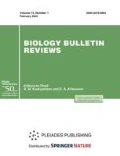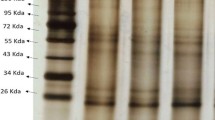Abstract
Symbiotic microbes affect many aspects of the life of multicellular organisms and may favor their adaptation to a changing environment, but there is little direct experimental evidence of such a contribution. To assess the possible role of the microbiome in the adaptation of Drosophila melanogaster to a high-NaCl feed substrate, we used two laboratory lines of salt-adapted flies (C1, C2) and two control lines cultivated on a standard feed without salt (H1, H2). We have already shown that the presowing of homogenate of flies C1 on the surface of a saline feed increases the breeding efficiency and enhances the development of drosophila larvae in comparison with a homogenate of H1 flies. We repeated this experiment for lines C2 and H2 and obtained similar data, which proves the reproducibility of the revealed effect. In addition, we found contrasting differences in the number and taxonomic composition of yeast in drosophila homogenates of the salt-adapted and control lines. The results correspond to the assumption that changes in the symbiotic microbiome, including its yeast component, may contribute to the adaptation of drosophila to unfavorable feed substrates. The possible evolutionary consequences of such a contribution are discussed in this work.



Similar content being viewed by others
REFERENCES
Anagnostou, C., Dorsch, M., and Rohlfs, M., Influence of dietary yeasts on Drosophila melanogaster life-history traits, Entomol. Exp. Appl., 2010, vol. 136, pp. 1–11.
Arbuthnott, D. and Rundle, H.D., Misalignment of natural and sexual selection among divergently adapted Drosophila melanogaster populations, Anim. Behav., 2014, vol. 87, pp. 45–51.
Blum, J.E., Fischer, C.N., Miles, J., and Handelsman, J., Frequent replenishment sustains the beneficial microbiome of Drosophila melanogaster, mBio, 2013, vol. 4, p. e00860.
Bordenstein, S.R. and Theis, K.R., Host biology in light of the microbiome: ten principles of holobionts and hologenomes, PLoS Biol., 2015, vol. 13, no. 8, p. e1002226.
Brummel, T., Ching, A., Seroude, L., Simon, A.F., and Benzer, S., Drosophila lifespan enhancement by exogenous bacteria, Proc. Natl. Acad. Sci. U.S.A., 2004, vol. 101, pp. 12974–12979.
Collins, N., Population ecology of Ephydra cinerea Jones (Diptera: Ephydridae), the only benthic metazoan of the Great Salt Lake, USA, Hydrobiologia, 1980, vol. 68, pp. 99–112.
Coluccio, A.E., Rodriguez, R.K., Kernan, M.J., and Neiman, A.M., The yeast spore wall enables spores to survive passage through the digestive tract of Drosophila, PLoS One, 2008, vol. 3, no. 8, p. e2873.
Crispo, E., The Baldwin effect and genetic assimilation: revisiting two mechanisms of evolutionary change mediated by phenotypic plasticity, Evolution, 2007, vol. 61, no. 11, pp. 2469–2479.
Dettman, J.R., Sirjusingh, C., Kohn, L.M., and Anderson, J.B., Incipient speciation by divergent adaptation and antagonistic epistasis in yeast, Nature, 2007, vol. 447, pp. 585–588.
Dmitrieva, A.S., Ivnitsky, S.B., and Markov, A.V., Adaptation of Drosophila melanogaster to unfavorable feed substrate is accompanied by expansion of trophic niche, Biol. Bull. Rev., 2017, vol. 7, no. 5, pp. 369–379.
Erkosar, B., Storelli, G., Defaye, A., and Leulier, F., Host-intestinal microbiota mutualism: “learning on the fly,” Cell Host Microbe, 2013, vol. 13, pp. 8–14.
Faria, V.G., Martins, N.E., Paulo, T., Teixeira, L., Sucena, E., and Magalhres, S., Evolution of Drosophila resistance against different pathogens and infection routes entails no detectable maintenance costs, Evolution, 2015, vol. 69, pp. 2799–2809.
Fitzpatrick, B.M., Underappreciated consequences of phenotypic plasticity for ecological speciation, Int. J. Ecol., 2012, art. ID 256017.
Fry, J.D., Detecting ecological trade-offs using selection experiments, Ecology, 2003, vol. 84, pp. 1672–1678.
Ganter, P.F., The vectoring of cactophilic yeasts by Drosophila, Oecologia, 1988, vol. 75, no. 3, pp. 400–404.
Glantz, S.A., Primer of Biostatistics, New York: McGraw-Hill, 1990.
Glushakova, A.M., Kachalkin, A.V., and Chernov, I.Yu., Specific features of the dynamics of epiphytic and soil yeast communities in the thickets of Indian balsam on mucky gley soil, Eurasian Soil Sci., 2011, vol. 44, no. 8, pp. 886–892.
Herbst, D.B., Gradients of salinity stress, environmental stability and water chemistry as a templet for defining habitat types and physiological strategies in inland salt waters, Hydrobiologia, 2001, vol. 466, pp. 209–219.
Kawecki, T.J., Lenski, R.E., Ebert, D., Hollis, B., Olivieri, I., and Whitlock, M.C., Experimental evolution, Trends Ecol. Evol., 2012, vol. 27, no. 10, pp. 547–560.
Kneitel, J.M. and Chase, J.M., Trade-offs in community ecology: linking spatial scales and species coexistence, Ecol. Lett., 2004, vol. 7, pp. 69–80.
Korol, A., Rashkovetsky, E., Iliadi, K., Michalak, P., Ronin, Y., and Nevo, E., Nonrandom mating in Drosophila melanogaster laboratory populations derived from closely adjacent ecologically contrasting slopes at “Evolution canyon,” Proc. Natl. Acad. Sci. U.S.A., 2000, vol. 97, pp. 12637–12642.
Kreslavskii, A.G., Sympatric speciation in animals: disruptive selection or ecological segregation, Zh. Obshch. Biol., 1994, vol. 55, nos. 4–5, pp. 404–419.
Long, T.A.F., Rowe, L., and Agrawal, A.F., The effects of selective history and environmental heterogeneity on inbreeding depression in experimental populations of Drosophila melanogaster, Am. Nat., 2013, vol. 181, pp. 532–544.
Margulis, L. and Fester, R., Symbiosis as a Source of Evolutionary Innovation: Speciation and Morphogenesis, Boston: MIT Press., 1991.
Markov, A.V. and Ivnitsky, S.B., Evolutionary role of phenotypic plasticity, Moscow Univ. Biol. Sci. Bull., 2016, vol. 71, no. 4, pp. 185–192.
Markov, A.V., Ivnitsky, S.B., Kornilova, M.B., Naimark, E.B., Shirokova, N.G., and Perfilieva, K.S., Maternal effect obscures adaptation to adverse environments and hinders divergence in Drosophila melanogaster, Biol. Bull. Rev., 2016, vol. 6, no. 5, pp. 429–435.
McFall-Ngai, M.J., Unseen forces: the influence of bacteria on animal development, Dev. Biol., 2002, vol. 242, pp. 1–14.
Panchenko, P.L., Kornilova, M.B., Perfilieva, K.S., and Markov, A.V., Contribution of symbiotic microbiota to adaptation of Drosophila melanogaster to an unfavorable growth medium, Biol. Bull. (Moscow), 2017, vol. 44, no. 4, pp. 345–354.
Rice, W.R. and Salt, G.W., The evolution of reproductive isolation as a correlated character under sympatric conditions: experimental evidence, Evolution, 1990, vol. 44, pp. 1140–1152.
Roff, D.A. and Fairbairn, D.J., The evolution of trade-offs: where are we? J. Evol. Biol., 2007, vol. 20, pp. 433–447.
Rosenberg, E., Sharon, G., and Zilber-Rosenberg, I., The hologenome theory of evolution contains Lamarckian aspects within a Darwinian framework, Environ. Microbiol., 2009, vol. 11, no. 12, pp. 2959–2962.
Rosenberg, E., Koren, O., Reshef, L., Efrony, R., and Zilber-Rosenberg, I., The role of microorganisms in coral health, disease and evolution, Nat. Rev. Microbiol., 2007, vol. 5, no. 5, pp. 355–362.
Sharon, G., Segal, D., Ringo, J.M., Hefetz, A., Zilber-Rosenberg, I., and Rosenberg, E., Commensal bacteria play a role in mating preference of Drosophila melanogaster, Proc. Natl. Acad. Sci. U.S.A., 2010, vol. 107, pp. 20051–20056.
Shin, S.C., Kim, S.H., You, H., Kim, B., Kim, A.C., Lee, K.A., Yoon, J.H., Ryu, J.H., and Lee, W.J., Drosophila microbiome modulates host developmental and metabolic homeostasis via insulin signaling, Science, 2011, vol. 334, pp. 670–674.
Starmer, W.T., A comparison of Drosophila habitats according to the physiological attributes of the associated yeast communities, Evolution, 1981, vol. 35, no. 1, pp. 38–52.
Starmer, W.T., Barker, J.S.F., Phaff, H.J., and Fogleman, J.C., Adaptations of Drosophila and yeasts: their interactions with the volatile 2-propanol in the Cactus–microorganism–Drosophila model system, Aust. J. Biol. Sci., 1986, vol. 39, pp. 69–77.
Stergiopoulos, K., Cabrero, P., Davies, S.A., and Dow, J.A., Salty dog, an SLC5 symporter, modulates Drosophila response to salt stress, Physiol. Genomics, 2009, vol. 37, pp. 1–11.
Storelli, G., Defaye, A., Erkosar, B., Hols, P., Royet, J., and Leulier, F., Lactobacillus plantarum promotes Drosophila systemic growth by modulating hormonal signals through TOR-dependent nutrient sensing, Cell Metab., 2011, vol. 14, pp. 403–414.
Te Velde, J.H., Molthoff, C.F.M., and Scharloo, W., The function of anal papillae in salt adaptation of Drosophila melanogaster larvae, J. Evol. Biol., 1988, vol. 2, pp. 139–153.
Tobler, R., Hermisson, J., and Schlutterer, C., Parallel trait adaptation across opposing thermal environments in experimental Drosophila melanogaster populations, Evolution, 2015, vol. 69, pp. 1745–1759.
Waddington, C.H., Genetic assimilation of acquired characters, Evolution, 1953, vol. 7, no. 4676, pp. 118–126.
Waddington, C.H., Canalization of development and genetic assimilation of acquired characters, Nature, 1959, vol. 183, pp. 1654–1655.
Wong, C.N., Ng, P., and Douglas, A.E., Low-diversity bacterial community in the gut of the fruitfly Drosophila melanogaster, Environ. Microbiol., 2011, vol. 13, pp. 1889–1900.
Yakovleva, E.U., Naimark, E.B., and Markov, A.V., Adaptation of Drosophila melanogaster to unfavorable growth medium affects lifespan and age-related fecundity, Biochemistry (Moscow), 2016, vol. 81, no. 12, pp. 1445–1460.
Zilber-Rosenberg, I. and Rosenberg, E., Role of microorganisms in the evolution of animals and plants: the hologenome theory of evolution, FEMS Microbiol. Rev., 2008, vol. 32, pp. 723–735.
Funding
This work was supported by the Russian Foundation for Basic Research, project no. 18-04-00915.
Author information
Authors and Affiliations
Corresponding author
Ethics declarations
Conflict of interest. The authors declare that they have no conflict of interest.
Statement on animal welfare. All applicable international, national, and/or institutional guidelines for the care and use of animals were followed.
Additional information
Translated by I. Bel’chenko
Rights and permissions
About this article
Cite this article
Ivnitsky, S.B., Maximova, I.A., Panchenko, P.L. et al. Microbiome Affects the Adaptation of Drosophila melanogaster to a High NaCl Concentration. Biol Bull Rev 9, 465–474 (2019). https://doi.org/10.1134/S2079086419050049
Received:
Published:
Issue Date:
DOI: https://doi.org/10.1134/S2079086419050049




